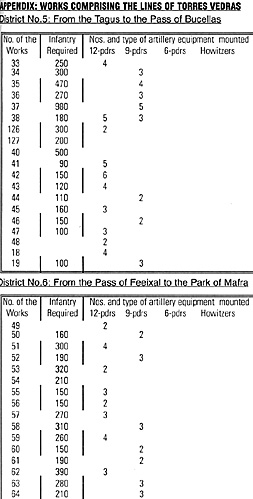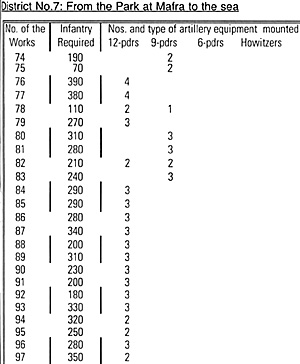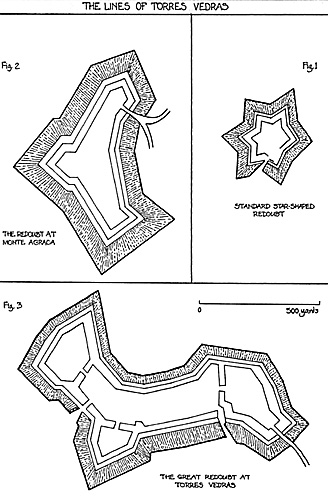Campaign in Portugal: Part I (AoN26)
 The works to cover an embarkation had to embrace an area of land sufficiently large enough to contain the whole army, along with all its artillery and its stores. They had to be strong enough to hold back the enemy for a number of days in case of adverse weather conditions.
The works to cover an embarkation had to embrace an area of land sufficiently large enough to contain the whole army, along with all its artillery and its stores. They had to be strong enough to hold back the enemy for a number of days in case of adverse weather conditions.
The outer perimeter at St. Julian was composed of a line of detached redoubts and intermediate defences. It extended for over 3,000 yards from the mouth of the Tagus near Fort das Maias to the Atlantic by the old tower of Junquiera. These fortifications embraced the town of Oeyras and the whole promontory of Fort St. Julian, and they were the first works to be started in the whole Torres Vedras programme. [9] Altogether, twelve seperate works were constructed in this outer semi-circle of defences. They were designed to accomodate seventy-four guns and over 4,000 defenders.
There was a further requirement for a smaller, fully enclosed post to be built within the principal trace of a much smaller size and strength. This could be held by a smaller number of men should a part of the army be left ashore because of the onset of a gale after the bulk had been embarked. This was provided by the construction of a substantial stone redoubt on the summit of the height immediately in front of Fort St. Julian. This work was to be garrisoned by 1,340 men and was armed with twenty 24-pounders. These were the heaviest ordnance mounted in any of the works in the Lines. There was a simple reason for concentrating all the big guns here. If the French turned any of the guns captured in the other redoubts upon this last post, they would be overmatched by these much heavier pieces.
The final consideration was for an impregnable position to protect the rearguard during the last moments of the embarkation. This was adequately met by Fort St. outer ravelin wall, down to the beach. Four jetties were also built on the shore to facilitate the boarding of the boats.
As the safety of the army might well depend upon the defences at St. Julian, they were subject to the tightest possible security. "You will give directions to the off icer who will command at St. Julian," Wellington wrote to Colonel Peacock at Lisbon, "to attend to the orders heretofore given respecting the works, and to allow no person whatever to go into or to inspect them, excepting the officers of the engineers or artillery." [10]
The works remained secret for many years after the war and, in Jones' account of the construction of the Lines of Torres Vedras published in 1846, plans of the St. Julian defences were intentionally omitted. "No plan is given of the positions of Almada, Oeyras (St. Julian) or Setubal, as it is possible they may, in the course of years, be again occupied." [11] This area continued to be occupied by the army, and the main work at St. Julian became a headquarters for NATO. Although the lines North of Lisbon were to be manned by native troops and militia ' the defences at St. Julian were to be occupied only by Royal Marines and regular British infantry.
As explained earlier, Wellington was convinced that the French would send a subsidiary corps through the Alentejo south of the Tagus. If this secondary invasion was to occur, it was probable that the enemy would attempt to establish batteries on the Almada heights that overlooked the Tagus estuary and the city of Lisbon. Guns situated on these heights could prevent the passage of shipping into Lisbon harbour and even bombard the capital. As a consequence, Wellington ordered Almada to be heavily fortified.
The defences at Almada covered a distance of over 7,000 yards, and consisted of possibly twenty detached redoubts. [12] In total, the defences were to hold 7,500 men and eighty-six guns. These defenders were composed in part from the Lisbon militia and members of the civic corps, supported by British marines and sailors landed from Admiral Berkeley's squadron. A signal station was erected at Almada castle which could communicate directly with Lisbon.
At Setubal, the secondary embarkation point south of the Tagus, a small line of seven redoubts was constructed. These defences incorporated eight windmills each being linked by a communication trench. This line was designed to be held by a single infantry division whilst the remainder of the army embarked.
[9] The St. Julian works began on 3 November 1809: R. Jones, An Engineer Officer under Wellington in the Peninsula, p.46.
Footnotes
[10] Wellington to Col. Peacock, Gouveia, 9 September 1810.
[11] There were of, of course, official plans and these are now held in the PRO, ref. nos. MR 939 and WO 78/2533.
[12] A. Norris and R.Bremner, The Lines of Torres Vedras, 1986, p.61.



Back to Age of Napoleon 27 Table of Contents
Back to Age of Napoleon List of Issues
Back to MagWeb Master List of Magazines
© Copyright 1998 by Partizan Press.
This article appears in MagWeb (Magazine Web) on the Internet World Wide Web.
Other military history articles and gaming articles are available at http://www.magweb.com